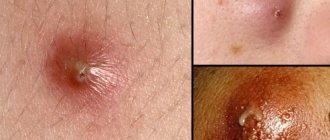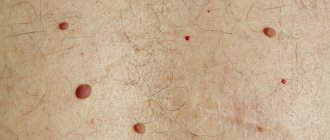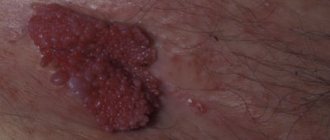Blisters in the groin with herpes type 2
Herpes can cause pathology not only on the lips, but also on the genitals.
The disease is transmitted through unprotected sexual contact.
Infection of a partner occurs both during active disease and when there are no manifestations.
Symptoms begin with the appearance of grouped blisters containing cloudy liquid in the genital area.
Then they rupture, and erosions and ulcers appear on the damaged area.
A little later they dry out and become crusty.
All periods of rash are characterized by painful sensations.
It is important to remember that the body is never completely free of the herpes virus.
A complete cure will not occur even with complete and competent therapy.
Therefore, a single appearance of herpetic blisters in the groin always leaves a risk of repeated rashes.
Recurrences of herpes infection are possible under the following conditions:
- other infectious diseases;
- exacerbation of chronic diseases;
- decreased level of immunity;
- hypovitaminosis;
- hypothermia;
- dysbacteriosis.
In each case of exacerbation, the best way out of the situation is to consult a doctor.
You should not be treated without prior consultation.
Blisters in the groin with herpes in pregnant women
The appearance of blisters in the genital area during pregnancy is dangerous for the unborn child.
Especially if the symptom is caused by the herpes virus.
This can lead to infection of the baby in the womb.
This situation threatens the development of the newborn.
Infection occurs during childbirth.
The infection is more severe than in the mother.
This is due to the fact that the child’s immune system is not perfect.
Therefore, it is necessary to diagnose and treat genital herpes in a woman during pregnancy.
The disease is characterized by blisters with cloudy liquid.
They are located in groups on the genitals.
The woman experiences pain and discomfort in this area.
Then the bubbles burst, leaving erosions and ulcers in their place.
The diagnosis can be made through laboratory testing of the contents of the vesicles.
Herpes virus type 2 is detected.
Treatment occurs locally with antiviral ointments and drugs to strengthen the immune system.
Blisters in the groin due to scabies
The risk group for groin scabies is men.
The most common location of scabies is the hands, from there it spreads to the penis.
Normally, blisters do not form with scabies.
The rash consists of blisters and papules.
The bullous form with blistering is rare.
The severity of scabies is not related to the number of mites.
It depends only on individual allergic reactions to pathogens.
A more common cause of the development of blisters is the addition of a secondary infection.
It occurs against the background of scratching in the groin.
Scabies causes severe itching.
The genital area contains a large number of bacteria.
Secondary infection develops relatively often.
The main therapy for scabies is carried out with antiscabiosis drugs.
Previously, special talkers were used for this.
The treatment took up to a week.
Now there are modern means.
They get rid of parasites in 1 – 2 applications.
Secondary infection, if present, requires additional therapy.
Blisters in the groin due to eczema
This disease is chronic and not contagious.
There are many reasons for it, but the exact etiology has not been identified.
Eczematous rashes can be located throughout the body.
During an exacerbation, bubbles with liquid form on the skin.
They burst, and erosions and crusts form in their place.
There are several stages of eczema:
- skin hyperemia;
- the formation of many small bubbles;
- getting wet;
- formation of crusts.
Any area of the skin can be affected, including the groin folds.
The disease causes severe itching in the affected areas.
The course of the disease follows the type of exacerbation - remission.
For eczema, a mandatory visit to a doctor is recommended.
Groin pain
Uterine cancer
Cervical cancer
Arthritis
49638 06 April
IMPORTANT!
The information in this section cannot be used for self-diagnosis and self-treatment.
In case of pain or other exacerbation of the disease, diagnostic tests should be prescribed only by the attending physician. To make a diagnosis and properly prescribe treatment, you should contact your doctor. Pain in the groin: causes of occurrence, what diseases it occurs with, diagnosis and treatment methods.
Definition
The groin, or groin area, is the part of the lower edge of the abdominal region adjacent to the thigh. In the projection of the groin area there is the inguinal canal, through which the spermatic cord passes into the scrotum in men, and the round ligament of the uterus in women.
When the walls of the inguinal canal weaken, loops of intestine can come out through it, forming an inguinal hernia.
Large vessels are located nearby - the femoral artery and the great saphenous vein of the leg, inguinal lymph nodes that collect lymph from the pelvic organs.
The anatomical proximity of the groin area with various organs and systems determines a huge variety of conditions in which groin pain can occur.
Types of groin pain
Groin pain can be unilateral or bilateral. It can develop quickly and intensely (acute) or slowly and gradually (subacute). Be short-term or chronic. Often pain in the groin area is referred, that is, radiating from some organ.
Possible causes of groin pain
Pain in the groin area can be either an alarming symptom, indicating the development of the disease, or observed in certain physiological conditions.
Doctors list the main causes of groin pain as:
- painful menstruation;
- corpus luteum of pregnant women (a temporary gland that produces progesterone, necessary to maintain pregnancy, and estrogen - sometimes the corpus luteum is enlarged, which can lead to pain);
- groin injuries;
- infectious and inflammatory diseases of the pelvic organs, including sexually transmitted infections;
- stretching and weakening of muscles and ligaments can occur in late pregnancy, with an inguinal hernia, abdominal proptosis, sprain of the adductor muscle of the thigh in athletes;
- oncological diseases of the pelvic organs;
- enlargement of inguinal lymph nodes in inflammatory and oncological diseases of the pelvic organs, lymphomas.
What diseases cause pain in the groin?
Pain in the groin can accompany diseases of the following organs and systems:
1) reproductive system:
- in women: inflammation of the ovaries, fallopian tubes, ovarian cyst, rupture of the ovarian cyst, inflammation of the vaginal mucosa, bacterial vaginosis, pathological growth of the endometrium (endometriosis), inflammation of the endometrium, ectopic pregnancy, uterine tumors, ovarian tumors, etc.;
- in men: testicular torsion, testicular hydatid torsion, inflammation of the testicle and its epididymis, dilatation of the scrotal veins, hydrocele, spermatic cord cyst, inflammation of the prostate, testicular cancer, prostate cancer, etc.;
2) urinary system:
urolithiasis, inflammation of the bladder and urethra, etc.;
3) intestines:
inflammation of an abnormally located appendix, inflammation of the rectum, diverticulitis, colic, cancer of the rectum, etc.;
4) musculoskeletal system:
herniated vertebral discs with compression of the spinal cord roots, arthrosis or arthritis of the hip joint, aseptic necrosis of the femoral head, etc.
Which doctors should I consult for groin pain?
First, you can contact your general practitioner, therapist or pediatrician. After establishing the probable cause of pain, the patient, if necessary, is referred to specialists: surgeon, gynecologist, nephrologist, urologist, neurologist, orthopedist, proctologist.
Diagnosis and examinations for groin pain
Before choosing a treatment method, the doctor must find out the nature, time and rate of increase in pain, whether the pain is unilateral or bilateral, clarify whether the pain is accompanied by an increase in temperature, discharge from the vagina, penis, urinary disorders (delay, pain, discomfort), whether there was blood in the urine, whether there was nausea and/or vomiting. The doctor pays attention to the patient’s gait and range of motion in the hip joint. Finds out whether there is pain somewhere else, for example, in the scrotum, abdomen, above the pubis, in the iliac region, in the lower back, thigh. It is important to know whether the pain was preceded by injury, increased physical activity, heavy lifting, or sexual contact. The specialist examines the groin, perineum, scrotum, checks for pathological formations in the scrotum, and assesses the condition of the muscles of the anterior abdominal wall and external inguinal ring.
For the purpose of differential diagnosis, patients are recommended to undergo a general blood test, a general urinalysis, an ultrasound examination of the pelvic organs, scrotal organs, urinary system organs, prostate gland, inguinal lymph nodes, it is necessary to examine urine culture, a smear on vaginal flora, and search for infections, sexually transmitted diseases (targeted, for example, gonococcus and chlamydia or as part of a comprehensive study).
Blisters in the groin due to dermatitis
Atopic dermatitis is a chronic disease.
As a rule, the first rashes occur in childhood.
Any area of the skin is involved in the pathological process.
The groin area is affected by dermatitis.
The disease is caused by heredity or occurs when the immune system fails.
Numerous blisters appear in the genital area.
They are filled with liquid.
The skin underneath is red and enlarged.
The bubbles burst and crusts form after them.
A distinctive feature of dermatitis is itching.
It intensifies at night.
After the acute process, the following remain:
- hyperemic areas of the skin with crust;
- scales on damaged skin;
- red or brown rash.
The disease progresses with periods of acute manifestations and remission.
To prevent symptoms from returning longer, you need to follow the rules.
When washing, use only hygiene products made from natural substances.
After showering, dry skin until moisture is completely removed.
Use a moisturizer without harmful chemical components.
This will avoid dry skin.
Rash in the groin in men
Candidiasis of the inguinal folds often develops
Candidiasis of the inguinal folds often develops, which is caused by fungi of the genus Candida:
with a decrease in immunity and level of hygiene, these microorganisms are activated.
Blisters appear on the skin, which subsequently turn into erosions, causing a red rash and itching in the groin.
Fungal infections also include inguinal athlete's foot:
it is caused by the fungus Epidermophyton, which is transmitted through the use of contaminated objects, towels, and clothing.
There are frequent cases of infection with this fungus in public baths.
With inguinal athlete's foot, reddish spots form on the skin.
They are accompanied by peeling, grow, and subsequently transform into rings with bubbles along the edges.
Skin allergy in the groin
A rash in the groin area in men is often a manifestation of an allergy to washing products, as well as to medications, food products, fabrics of underwear and trousers.
Elements of the rash in pruritic dermatosis are represented by plaques and nodules.
They are reddish in color and very itchy.
Chronic dermatosis is characterized by a change in the skin pattern, the appearance of areas with a shiny surface, and crusts form in places where scratching occurs.
An allergic rash in the groin in men tends to recur if contact with the allergen does not stop.
If this condition is not treated, a bacterial infection may develop and the rash may spread.
Syphilis and genital herpes - rashes in the groin in men
During syphilis, three periods are distinguished, the first and second of which are characterized by the appearance of syphilides on the skin and mucous membranes of the penis.
A rash in the groin area and other areas of the skin is characteristic of secondary syphilis.
Its elements are varied: spots, nodules, plaques.
Periods of rash are accompanied by malaise and increased body temperature, then pass, and remission occurs.
A syphilitic groin rash in men can often be confused with an allergic reaction.
Special tests help identify syphilis: Wasserman reaction, Treponema pallidum precipitation reaction and others.
Genital herpes is also transmitted through sexual contact.
It is characterized by the formation of bubbles with transparent contents, which burst and form painful erosions.
The herpes rash in the groin is usually very painful and itchy.
These rashes tend to spread quickly if left untreated.
Pemphigus in the groin in men
This disease occurs more often in men over 40 years of age.
With pemphigus vulgaris, a blistering rash appears on the skin of the groin area.
The elements of which merge with each other, cause pain, cause severe burning and itching.
Among the reasons for the appearance of pemphigus are metabolic disorders, hormonal imbalance, and exposure to a virus.
Rash in the groin in men with diaper rash
The reason that a rash appears in the groin area in men may be simple diaper rash.
Men with increased body weight are prone to this.
This situation occurs especially often during the hot season.
Diaper rash often appears in the fold area, including the groin area.
Treatment for diaper rash is quite simple, however, it requires careful attention.
The area is dried and lubricated with antibacterial cream.
You can use various baby powders to remove excess moisture.
If diaper rash does not go away, you should see a doctor.
Remember! Red rashes in the groin in men, similar at first glance to diaper rash, may be the cause of another disease.
Rash due to lice pubis
Many people think that pediculosis is practically non-existent now.
Unfortunately, it is not.
The disease is highly contagious and can be easily contracted.
If a rash and itching appears in the groin of men, these may be ordinary pubic lice.
To diagnose this situation, an external examination by a specialist is sufficient.
If pediculosis is diagnosed, appropriate treatment is prescribed.
The drug is applied in the form of shampoo or spray to the affected areas.
It is recommended to shave the hair if you have pubic lice.
Once the pathogen is destroyed, the rash goes away.
If this does not happen, then you need to look for another cause of the rash.
Rash due to ingrown hair in the groin
We often see skin irritation and red rashes after unsuccessful hair removal or shaving.
Usually this phenomenon goes away after a few days.
If hair removal was done a long time ago and a rash appears, it could be an ingrown hair.
A weak hair cannot grow fully through rough skin.
For this reason, it curls up, remaining inside it.
A local inflammatory process develops around such a hair.
In another way, this is also called inflammation of the follicle against the background of an ingrown hair.
This type of rash is quite easy to treat.
Ingrown hairs are removed and the area is lubricated with an antibacterial compound.
It is better to prevent the appearance of ingrown hairs.
To do this, you should use a scrub after hair removal.
It is recommended to do more modern hair removal using laser techniques or Elos therapy.
Such methods practically do not leave behind ingrown hairs.
Diabetes rash in groin
Diabetes mellitus is a systemic disease that affects the entire body.
Against this background, immune processes are weakened, and a tendency to various inflammatory diseases appears.
If you gain weight and lead a sedentary lifestyle, this contributes to the occurrence of infection.
If you have a groin rash due to diabetes, be sure to tell your doctor about your underlying condition.
This will facilitate the diagnostic search and treatment of the process.
Streptococcal impetigo and folliculitis in the groin in men
A fairly common cause of the rash is streptococcus.
The process develops in the groin with profuse sweating.
This place could not be more suitable for bacteria.
Folliculitis in the groin in men can develop due to insufficient hygiene procedures or due to clogged pores.
To prevent these conditions, you should follow the rules of personal hygiene and shower regularly.
Rash in the groin area in men: what to do
If you find any suspicious rashes in the groin of men, you should immediately contact a medical center.
The sooner the diagnosis is made, the easier the treatment process will be.
Rash in the groin in men: treatment
In order to treat a disease, its cause must be found out.
First of all, the doctor carries out diagnostic measures.
Once the diagnosis is established, treatment is prescribed.
If a groin rash in men caused by a fungus is detected, it can be treated with local antifungicidal therapy.
The doctor will prescribe the appropriate treatment, depending on the type of fungus that caused the rash.
Rash in the groin area in men: prevention
- Avoid casual relationships and use barrier contraceptive methods
- Follow normal hygiene rules
- Don't wear synthetic underwear all the time
- Monitor your weight and follow the diet recommended by your doctor
- Get checked regularly for chronic conditions
Rash in the groin in men: which doctor to see
If a rash appears in the groin, you should consult a dermatovenerologist.
He identifies the causes and prescribes the correct treatment.
Due to self-medication, there is a risk of developing dangerous complications.
For any groin rash in men, contact the author of this article - a venereologist, dermatologist in Moscow with 15 years of experience.
Blisters in the groin due to allergies
Wearing synthetic underwear may cause rashes in the genital area.
Food allergies cause blisters on the genitals.
If a person has eaten something allergenic, a rash will appear within 24 hours.
When wearing underwear made from artificial materials, bubbles will appear after skin contact with the fabric.
The rash is accompanied by severe itching and hyperemia.
Often, allergies develop to topical medications.
These include ointments, lotions, creams, and local antiseptics.
Another common cause is contraceptives and lubricants.
Blisters in the groin area can also occur after using intimate toys containing latex.
The size of the bubbles and the severity of the discomfort depend on the severity of the reaction.
In addition to rashes, severe tissue swelling may develop.
Any allergic reaction requires contacting a specialist.
If you have a rash in the groin, you should in any case go to a dermatovenerologist.
This is due to the similarity of the symptoms of these diseases with sexually transmitted diseases.
Allergy treatment depends on the severity of the symptoms and the overall severity of the condition.
The main remedies are to stop contact with the allergen and take antihistamines.
Medicines can be used by injection, orally, and topically.
Sometimes a form of allergic reaction such as urticaria develops.
Blisters appear on the body and are very itchy.
After two to three hours they are replaced by the general reaction of the body.
Nausea, vomiting, and pain in the abdomen occur.
Typically, antihistamines and avoiding contact with the allergen help in this situation.
Reasons for appearance
The appearance of redness and rash in the groin in men can be caused by a variety of reasons - from rubbing with tight underwear and allergies to hygiene products to chronic diseases or acute infections.
Most often, such pathological changes in the skin are caused by:
- wearing uncomfortable, rough or ill-fitting underwear;
- excessive sweating;
- failure to comply with hygiene rules, use of irritating hygiene products;
- skin diseases (candidiasis, dermatitis, psoriasis, etc.);
- STD (syphilis);
- obesity;
- diabetes mellitus;
- neuroses, stressful situations;
- allergic reactions;
- long-term use of antibiotics;
- decreased immunity.
The most common and most harmless cause of redness of the skin in the groin area in men is improperly selected synthetic underwear and poor hygiene, especially in hot weather, when sweating increases greatly.
A venereologist talks about the causes of redness in the groin in men.
Linen and hygiene
Potential triggers for redness and rashes in the groin in men include tight synthetic underpants. Wearing them leads to the formation of abrasions, followed by infection and spread of the rash.
Synthetics, closely adjacent to the body, contribute to the occurrence of such negative processes:
- allergic reactions;
- irritation, abrasions;
- increased sweating;
- development of pathogenic bacteria.
Most often in such cases, the groin area is affected in men who neglect personal hygiene. Sweat and other skin secretions accumulate in the folds of the skin, mix with dirt and activate the development of bacteria. This leads to inflammation of even the slightest abrasions and further development of infection.
In addition, rashes in the groin may appear even with careful hygiene procedures if unsuitable detergents are used. They can dry out the skin excessively or cause an allergic reaction, which is also manifested by redness of the skin and the appearance of various rashes.
Also, the cause of such lesions can be overweight or diabetes. In such cases, irritation in the groin area is not accompanied by itching and is essentially diaper rash. This inflammatory lesion occurs due to excessive friction or constant moisture of the skin. Diaper rash initially manifests itself only as redness with a slight burning sensation, spreading symmetrically on both sides of the skin fold. Then erosions may form and secondary infections may occur.
Dermatitis
Inguinal dermatitis in men develops under the influence of mechanical, chemical or biological factors, the main of which are:
- allergies to hygiene products and detergents;
- consequences of wearing synthetic underwear;
- diabetes;
- infectious diseases.
Another type of dermatitis affecting the groin area - perianal - begins with inflammation around the anus and manifests itself with similar symptoms, which over time spread to the perineum and the entire groin. In men, this disease develops due to:
- intestinal microflora disorders;
- diseases of the rectum;
- hemorrhoids, anal fissures:
- prolonged diarrhea;
- poor hygiene;
- urinary or fecal incontinence;
- inflammatory diseases of the gastrointestinal tract;
- damage to the skin around the anus and its infection;
- constant use of a car (Jeep disease), which leads to the penetration of broken hair into the skin around the anus;
- HIV infections, AIDS;
- long-term antibiotic or hormonal therapy.
In addition to general symptoms, each type of groin dermatitis in men manifests itself with specific symptoms:
- bacterial - the formation of purulent blisters, erosions, weeping areas, crusts;
- fungal - the presence of scalloped rims of the affected area, flaky surface, white plaque, pustules and blisters along the edges;
- allergic - severe itching, the appearance of nodules with transparent yellowish contents, which, when opened, form erosive areas;
- perianal abscess fistulous (Jeep disease) - the development of recurrent foci of inflammation and the formation of fistulas in the tissues of the anus.
Seborrheic dermatitis is also a common cause of damage to the groin area in men. This is a chronic disease, usually worsening in autumn and winter and manifested by an itchy, pinpoint rash.
Note! Dermatitis in the groin in men, regardless of the type and causes of its occurrence, extends to the entire groin area. The disease is manifested by redness, the formation of a blistering rash, swelling, swelling and hyperthermia of the affected area.
Mycoses
If redness and rash in the groin in men are accompanied by itching, most often their cause is fungal infections. The most common of them include:
- Athlete's inguinal infection is transmitted through household contact or through normal contact. The risk of infection increases especially in case of poor personal hygiene, excessive sweating or skin damage. The disease manifests itself as red spots edged with an inflamed, swollen rim covered with small scales. Closer to the center of the spot, there are practically no signs of inflammation, and the shape becomes ring-shaped. In addition to spots on the body, there are rashes located in random order.
- Rubromycosis is a fungal infection transmitted through contact with a sick person or contaminated public objects. A characteristic difference between rubromycosis and the previous disease is the dotted appearance of the rim and the absence of rashes on the body.
- Candidiasis of the inguinal folds is caused by an opportunistic fungus that lives on the skin and becomes active when the immune system is weakened. It first appears as redness and swelling of the affected area, which eventually develops into a blistering rash. Then the opening blisters unite into weeping erosive areas with single papules along the edges.
Despite the predominantly contact and household routes of infection, all fungal infections, manifested by a rash and redness in the groin of a man, are transmitted mainly through sexual intercourse.
Erythrasma
Erythrasma is a bacterial infection from the group of pseudomycosis, the causative agent of which is also opportunistic and can live on the skin asymptomatically. The development of erythrasma can be facilitated by the creation of favorable conditions for it:
- increased sweating;
- lack of personal hygiene;
- chafing the skin.
Infection can also be caused by contact (especially sexual contact) with an infected person.
Erythrasma is manifested by the formation in the groin area of non-inflamed large spots of a reddish or pale brown color with a smooth or scaly surface. In some cases, they are edged with a swollen rim and have a pale center. Itching is almost always absent.
Lichen planus
Lichen planus is a chronic infectious inflammation of the skin in the groin area in men, which is accompanied by rashes in the form of small shiny reddish nodules with a depression in the center. The cause of the disease is considered to be disorders of the immune system and metabolic processes in the body, which result in an inadequate response to external influences.
Also, the formation of lichen can be caused by other factors:
- hereditary predisposition;
- allergic reactions;
- viral infection;
- neuroses, stress.
In its manifestations in the groin of men, lichen ruber resembles syphilitic rashes. The main differences are:
- irregular polygonal shape;
- the presence of a depression in the center of the nodule;
- fine mesh surface;
- no hemorrhages.
Lichen planus is also often confused with psoriasis. To clarify the diagnosis, laboratory tests are performed to exclude other diseases, since with lichen there are no specific changes in blood or urine parameters.
Psoriasis
The development of psoriasis, which can appear in the groin of men, is caused by accelerated maturation and death of skin cells. The causes of this pathological process may be:
- heredity;
- damage to the nervous system;
- chronic stress.
Inguinal psoriasis is manifested by the formation of smooth reddish plaques, which over time begin to crack and peel, causing pain.
Syphilis
Red rashes in the groin in men are an external manifestation of syphilis - a dangerous infection, transmitted mainly through sexual contact and in the final stage, leading to damage to all tissues with fatal outcome.
The appearance of pale rashes in the groin area is a sign of the second stage of this disease. Along with the rash, which eventually spreads throughout the body, the patient experiences cold symptoms - headaches, aches, and hyperthermia. With the development of secondary syphilis, the rash collects in large white spots.
The danger of the disease is due to the fact that the rashes appear in waves, alternating, like other symptoms, with periods of remission. In this form, syphilis can last for a long time - sometimes worsening, sometimes subsiding. If left untreated, this process ends in painful death.
Which doctor should I see for blisters in the groin?
The occurrence of such a symptom causes discomfort in a person.
Many diseases are accompanied by pain.
It is important to consult a doctor in this situation.
A dermatovenerologist can help with skin diseases.
If the process is caused by sexual intercourse and there is an infectious disease, then the intimate area is affected.
In this case, a dermatovenerologist can help.
There are specialized dermatovenerological clinics.
They treat patients with various skin lesions.
What tests are prescribed for blisters in the groin?
To accurately determine the diagnosis, it is necessary to undergo laboratory tests.
The patient donates blood, which determines active inflammation.
Elevated levels of immunoglobulin E may be detected in the blood.
It indicates the presence of atopic dermatitis or an allergic reaction.
Additionally, skin tests with allergens are performed to determine the cause of these diseases.
When blisters appear on the skin, the immune system is examined.
Many diseases arise against the background of reduced protective properties of the body.
A scraping is taken from the blisters and subjected to various laboratory diagnostic methods.
This is how the herpes virus is detected.
Cytological examination can reveal acantholytic cells.
They appear with pemphigus.
These measures are carried out to make a correct diagnosis.
A correctly identified disease can be properly treated.
The patient gets rid of blisters in the groin area.
Prevention methods
The main measure to prevent redness and rash in the groin in men is strict adherence to the rules of personal hygiene and wearing loose, natural underwear. You need to wash the groin area at least 2 times a day with suitable hypoallergenic products, and if you sweat excessively, use baby powder after each water procedure (on well-dried skin).
In addition, in everyday life you need to adhere to several rules:
- promptly treat diseases identified during diagnosis;
- provide protection during sexual intercourse by always using a condom during casual relationships;
- wear underwear made of natural fabrics and a loose fit;
- strengthen the immune system by eating fully and correctly;
- lead a healthy lifestyle;
- For any manifestations in the groin area, immediately contact a specialist.
Redness and rash in the groin in men can be external symptoms of serious diseases. Only a doctor can install and cure them. Therefore, even if you suspect normal irritation or diaper rash, you should first undergo an examination and then carry out appropriate treatment. Do-it-yourself activities can cause irreparable harm and blur the main symptoms, which will significantly complicate the diagnosis and lead to the loss of precious time.
Treatment of blisters in the groin
Therapy is determined strictly by the doctor and depends on the cause of the bubbles.
For various types of herpes, antiviral drugs are prescribed.
They are able to remove local symptoms.
At the same time, it is recommended to take a course of immunomodulatory drugs.
Exacerbation of infection and the appearance of blisters is provoked by a weakening of the body's immune system.
When prickly heat occurs, it is important to follow the rules of intimate hygiene.
An antiseptic is applied to the damaged area.
Antihistamines are used against eczema.
To stop the inflammatory process, enzymes and immunomodulators are prescribed.
If swelling is pronounced, diuretics are used.
For local treatment, medications are applied to the damaged area.
Eczema can be triggered by severe nervous tension and stress.
Therefore, it is recommended to use sedatives.
For dermatitis, glucocorticoid hormones are prescribed in local preparations - ointments, creams.
It is important to exclude contact with provoking factors.
Pemphigus is treated with high-dose glucocorticoids.
Hemosorption, cryoapheresis, and membrane plasmapheresis are used.
Weak antiseptics are applied locally.
Common to all diseases is the prescription of a diet.
Exclusion from the diet of spicy, fried, fatty foods.
People with chronic skin diseases are advised to avoid stressful situations.
Complications
Any blisters in the groin area are a violation of the integrity of the skin.
Bacteria can enter an open wound.
They cause a purulent inflammatory process in the damaged area.
The doctor additionally prescribes antibacterial agents.
Treatment of the main cause of the disease is delayed.
Therefore, it is important to immediately contact a dermatovenerologist if you notice skin rashes in the groin.
He will examine the patient, conduct diagnostics, make the correct diagnosis and prescribe treatment.
This will allow you to get rid of the disease and its manifestations.
Diagnosis and treatment
The diagnosis is individual in each case. The initial examination takes into account the nature, type, timing of appearance, localization of skin lesions in the groin area in men, as well as the presence of other symptoms.
The final conclusion, if necessary, is made based on the results of laboratory tests. Depending on the causes of redness and rash, appropriate treatment is prescribed. It can be aimed both at eliminating external manifestations and at getting rid of the underlying disease that caused pathological changes in the skin.
Drug therapy
If problems in the groin area in men are caused by external influences, to get rid of them it is necessary to eliminate the irritating factor and carry out local treatment. The following medications are used to treat diaper rash and irritation:
- Bepantol cream - ensures rapid restoration of the skin, promotes instant drying of abrasions and wounds;
- cream "Desitin" - creates a protective film from natural components that accelerate tissue healing and regeneration, and also prevent the aggressive effects of sweat and urine on the skin, which is most important when it is not possible to carry out hygiene procedures during the day;
- ointment "Drapolen" - an antiseptic with a softening and soothing effect on the skin;
- Lamisil cream - destroys fungal infections of all types;
- gel "Pantestin" - prevents the development of infection, has an antiseptic and anti-inflammatory effect, but contains alcohol, which greatly dries the skin;
- zinc ointment - eliminates redness and itching, dries out inflammation.
All of these drugs have a mild effect on the skin and have a good effect in treating redness and rash in the groin in men.
Note! If redness, rashes, itching and other symptoms cannot be eliminated with cream or ointment within 1 month, you should contact your dermatologist again. The doctor will prescribe stronger medications or conduct additional examinations to clarify the causes of the pathology.
Treatment of the disease that has become the root cause of redness and rash in a man’s groin should only be prescribed by a doctor. Most often, antihistamines, antifungals, hormonal, antiseptics and other drugs are used for these purposes, which are chosen strictly depending on the diagnosis. In addition, sedatives can be used to relieve the clinical picture of the disease and traditional medicine recipes to speed up recovery.
Folk remedies
To get rid of redness and rashes in the groin in men, medicinal plants and vegetable oils are widely used. The recipes for their use are quite simple:
- Local baths from herbal infusion - brew 6 tbsp in 2 liters of boiling water. l. plant materials (chamomile, calendula, string, oak bark - can be separately or mixed in arbitrary proportions). Let it brew, filter, dilute in 10 liters of warm water.
- Lotions - in the infusion prepared according to the above recipe, moisten a soft cloth and apply to the affected area for 20 minutes.
- Vegetable oil (sunflower, olive, flaxseed or any other) - steamed for 30 minutes to sterilize. Then lubricate the skin to soften and eliminate dryness.
It should be borne in mind that folk remedies can only be used in combination with classical treatment. Home treatments cannot replace therapy prescribed by a doctor.
Diagnosis of blisters in the groin
The primary diagnosis of the causes of blisters in the groin area is performed by a doctor during a clinical examination of the patient at an appointment.
He thoroughly determines the time of appearance of the bubbles, the presence of accompanying pain or itching.
The influence on their expression of various physiological processes in the body.
After a clinical examination, based on the results obtained, the specialist prescribes additional diagnostics.
It includes various laboratory research techniques aimed at identifying and identifying pathogenic (disease-causing) microorganisms.
Diagnosis is carried out using:
- microscopy,
- PCR,
- ELISA
- allergen through skin testing (injecting a small amount of a diluted solution of the most common allergens into a small area of skin).
Treatment of blisters in the groin
Effective treatment of such manifestations as blisters in the groin in men or women is possible only after eliminating the impact of the cause of their development.
For herpes infection, various medications are used, which include antiviral drugs.
They come in local (ointments, creams) and systemic (droppers, tablets, capsules) action, active against the herpes virus.
In the case of a diagnosed allergic reaction, the main measure is to prevent repeated contact of the skin of the groin area with the allergen.
To reduce the severity of itching and burning that may accompany the appearance of blisters, anti-inflammatory drugs are used for local use.
If any blisters appear in the groin, contact the author of this article - a dermatovenerologist, urologist in Moscow with 15 years of experience.
Features of the pathology
The type of pathological changes in the skin in the groin area depends on the nature of the irritant or pathogen that led to their appearance. Such lesions can manifest themselves as various rashes, redness, itching, burning, pain, the formation of ulcers and scratching with the introduction of infection.
Note! If redness and rash in the groin in men is left untreated, the process can worsen, affecting larger areas of the skin. This is fraught with the development of multiple complications, including systemic damage to the body.
Redness and rash
A change in skin color is the first sign of a violation of their integrity due to irritation, diaper rash, fungal, sexually transmitted or other infections. Most often, redness in such cases is caused by the appearance of a small rash, consisting of small blisters, which then merge into one red spot.
Without immediate treatment, the redness and rash progresses over time, affecting a larger area. As a rule, the process begins in the skin folds and then spreads to the scrotum, penis, perineum, and anus. hips.
Itching, pain
Almost always, redness and rash in the groin area in men are accompanied by itching. Such sensations cause significant physical and moral discomfort, worsen the quality of life, interfere with any communication, and deprive one of confidence in the intimate sphere.
Due to damage and scratching, over time the rash sites begin not only to itch, but also to hurt. Peeling, cracks, and wounds appear on the skin, through which bacteria, fungi, and other infections very easily penetrate. Their development subsequently leads to the appearance of ulcers and ulcers. Such pathologies can pose a serious danger and require complex treatment under medical supervision.











